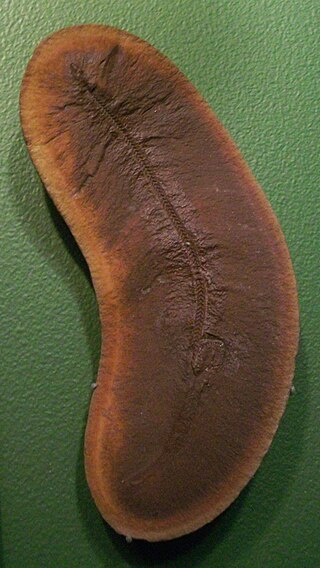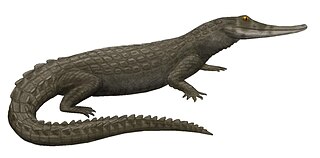
Gulo is a genus of carnivoran mammals in the family Mustelidae. It contains one extant species, the wolverine, as well as several extinct ones. Fossil evidence suggests that this genus appeared in North America and later spread to Eurasia during the Pliocene. Diagnostic traits include a strongly reduced P2, a robust P4 with three roots, and upper molars smaller than in other gulonines. Overall, the teeth are adapted for hypercarnivory.

Thylacinus is a genus of extinct carnivorous marsupials in the family Thylacinidae. The only recent member was the thylacine, commonly also known as the Tasmanian tiger or Tasmanian wolf. The last known Tasmanian tiger was in the Beaumaris Zoo in Tasmania, eventually passing away in 1936. The earliest known member of the genus, Thylacinus macknessi appeared during the Early Miocene, around 16 million years ago, and was smaller than the modern thylacine, with a body mass of about 6.7–9.0 kilograms (14.8–19.8 lb). Thylacinus represented the only extant genus of the family after the beginning of the Pliocene around 5 million years ago. Over time members of the genus saw an increase in body mass and a greater adaption to hypercarnivory in their dental morphology.

The Gray Fossil Site is an Early Pliocene assemblage of fossils dating between 4.5 and 4.9 million years old, located near the town of Gray in Washington County, Tennessee. The site was discovered during road construction on Tennessee State Route 75 by the Tennessee Department of Transportation in May 2000, after which local officials decided to preserve the site for research and education. The site became part of East Tennessee State University, and the Gray Fossil Site & Museum was opened on the site in 2007.

Scleromochlus is an extinct genus of small pterosauromorph archosaurs from the Late Triassic Lossiemouth Sandstone of Scotland. The genus contains the type and only species Scleromochlus taylori, named by Arthur Smith Woodward in 1907.

Jixiangornis is a genus of basal avialans from the Early Cretaceous. Like later avialans, it had no teeth, but it also had a long tail, unlike modern birds. Since teeth were still present in some more derived short-tailed avialans, Jixiangornis seems to have evolved its toothlessness independently of modern birds. The long forelimb indicates at least some aerial ability. Jixiangornis is currently known only from a single specimen, a complete but juvenile skeleton. The fossil was found in the Yixian Formation near Beipiao City, western Liaoning, China.

Ticinosuchus is an extinct genus of suchian archosaur from the Middle Triassic of Switzerland and Italy.

Guloninae is a subfamily of the mammal family Mustelidae distributed across Eurasia and the Americas. It includes martens and the fisher, tayra and wolverine. These genera were formerly included within a paraphyletic definition of the mustelid subfamily Mustelinae.

Pseudophlegethontia is an extinct genus of aïstopod tetrapodomorphs. It is the only member of the family Pseudophlegethontiidae. The only species is the type species P. turnbullorum, named in 2003. Fossils of Pseudophlegethontia have been found from the Mazon Creek fossil beds in Grundy County, Illinois, a conservation lagerstätte well known for the exceptional preservation of middle Pennsylvanian taxa.

Isisfordia is an extinct genus of crocodyliform closely related to crocodilians that lived in Australia during the Middle Cretaceous (Albian–Cenomanian).

The West Coast Fossil Park is a fossil park near Langebaanweg, Western Cape, South Africa, approximately 150 kilometres (93 mi) north of Cape Town. The fossil sites of Langebaanweg have exceptionally well-preserved remains of fossil fauna that date to circa 5.2 million years ago. In this period, sea levels were higher and many now extinct animals lived in the riverine forests, wooded savanna and along the sea coast near the present day Langebaanweg site. Phosphate mining operations at Langebaanweg uncovered these rich fossil deposits. The fossils include bones of over 200 different animal species. This represents possibly the greatest diversity of five-million-year-old fossils found anywhere in the world. The fossil park was formed after mining operations ceased in 1993. The park is partnered with the Iziko South African Museum.
Fugusuchus is an extinct genus of archosauriform, probably the basal-most member of the family Erythrosuchidae. The genus is known from a single fossil from the middle Early Triassic Heshanggou Formation in Shanxi, China. The partial skeleton consists of an incomplete skull, parts of the right forelimb, and an intercentrum. The skeleton, known as GMB V 313, is currently in the Geological Museum of China in Beijing.
Blomosuchus is an extinct genus of archosauriform from the Early Triassic of Russia. The type species was named in 1992 as Blomia georgii. However, the name Blomia was preoccupied by a genus of mites in the family Glycyphagidae (Blomia), so the genus was renamed Blomosuchus in 1997. Fossils of Blomosuchus have been found along the Vetluga River besides fossils of another problematic archosauriform, Vonhuenia.

The Western North Carolina Nature Center is a 42-acre (17 ha) zoological park in Western North Carolina operated by the City of Asheville's Parks and Recreation department. Until 1973, it was known as the Asheville City Zoo and was then renamed the Children's Zoo and Nature Center. It received its current name in 1974 when formed as a non-profit charity to develop the zoo which ultimately opened in 1976. The Center has been accredited by the Association of Zoos and Aquariums since 1999 and its collection features animals native to the southern Appalachian Mountains. In 2013 the center welcomed over 107,000 guests with over 13,000 coming from school children on field trips to the facility.

Jimusaria is an extinct genus of dicynodont therapsid from the Late Permian (Changhsingian) of China. The type species J. sinkianensis from the Guodikeng Formation in Xinjiang, was originally named as a species of Dicynodon, the first from Asia, but was given its own genus in 1963 before being sunk back into Dicynodon in 1988. The genus was resurrected in 2011 by palaeontologist Christian Kammerer in a taxonomic revision of the genus Dicynodon. Jimusaria was a mid-sized dicynodont, and was similar in appearance to the South African Dicynodon, but differed from it in features such as its narrower snout. A second species, Jimusaria monanensis was described from the Naobaogou Formation of northern China in 2023.

Rhinochelys is an extinct genus of sea turtles belonging to the family Protostegidae.

Santanmantis is an extinct genus of mantises, the sole genus in the family Santanmantidae. The only species, Santanmantis axelrodi, is known from the Crato Formation of Brazil, dating to the late Aptian stage of the Early Cretaceous. It is amongst the most primitive known lineages of mantis. Like other mantises, the forelegs are modified into spined raptorial appendages. When describing a new specimen in 2017, Hörnig, Haug and Haug proposed that the second set of legs also had spines similar to the forelegs, and also served a raptorial function, but that they were not visible in the fossil due to being broken off. However a response to this paper criticised this assumption, finding that it had little evidence from the fossil itself or from living mantises.
The Naobaogou Formation is a geological formation in the Daqing Mountains of China. It is likely of Lopingian age. It consists of three rhythms of sediment, labelled members I-III primarily of purple siltstone, but each with a thick basal conglomerate bed. It is notable for its fossil content, producing one of the most diverse Late Permian vertebrate faunas outside Russia and South Africa.

Solnhofia is a genus of extinct thalassochelydian turtle from the Late Jurassic of Germany. The type species is Solnhofia parsonsi, named by Gaffney in 1975 for a partial skull and jaw from the early Tithonian of the Solnhofen Formation in Bavaria. Additional material including a complete skeleton is known from the late Kimmeridgian of Switzerland and the Kimmeridgian/Tithonian of other deposits within Bavaria, and potentially also unprepared material from the Late Jurassic of France. The genus was referred to the family Eurysternidae by Anquetin and colleagues in 2017, which may represent an artificial grade of early thalassochelydians. In 2020 a new species Solnhofia brachyrhyncha was described from the Kimmeridigan aged Reuchenette Formation of Switzerland.

Menefeeceratops is a genus of ceratopsid dinosaur from the Menefee Formation in New Mexico, United States. It is potentially the oldest known member of the ceratopsids, as well as the centrosaurine subfamily, related to animals including Yehuecauhceratops and Crittendenceratops. The type and only species is Menefeeceratops sealeyi, known from a partial, non-articulated skeleton.

Attenborolimulus is an extinct genus of horseshoe crab with one known species: Attenborolimulus superspinosus. This genus is known from the Petropavlovka formation, dating to the Olenekian age, and is named after David Attenborough for his work in conservation and science communication.


















